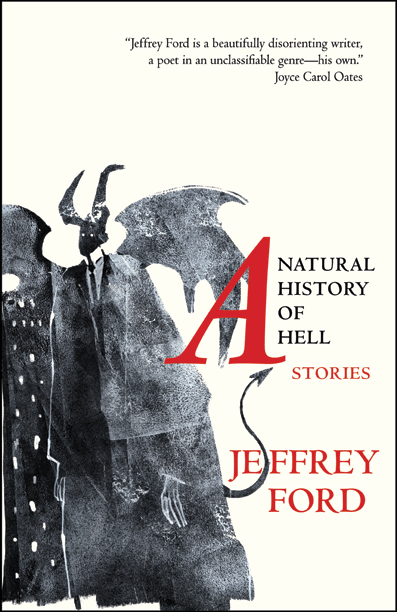What We’re Reading: A Natural History of Hell

 A Natural History of Hell by Jeffrey Ford (Small Beer Press, July 2016)
A Natural History of Hell by Jeffrey Ford (Small Beer Press, July 2016)
Jeffrey Ford is an author I’ve loved for some time. I read Crackpot Palace a few years ago and then immediately reread it. He was doing stuff in that collection I hadn’t seen before; his work was hard to categorize, hugely imaginative, and full of heart. And in A Natural History of Hell, Ford has continued to do all of that and more. Here we have Emily Dickinson enjoying Death’s company for a bit, a town at once protected and beset by a malicious, dangerous angel, an early 20th century Ohioan ghost story, and more. Ford’s new collection runs the gamut of genre and careens past the edges. (And it’s got a killer cover by Jeffrey Alan Love–look at that thing!)
A Natural History of Hell is a chimera: his stories combine surrealist (il)logic with both terrifying and familiar characters and situations. The stories braid together fantasy and history, the near-biography with the almost-mystery, and the result is surprising and enchanting and wonderful. Ford shows in this collection that perhaps his greatest gift is his fitness; he moves between different kinds of stories (the mythic and creepy “A Natural History of Autumn,” the down-home, small-town “Word Doll”) with such ease and mastery. It’s more than a little freaky.
The hope of a collection of mostly-already-published work is to create a conversation between the pieces that didn’t exist before, to offer new contexts for familiar texts. I’m not sure that’s totally achieved with Ford’s new collection, though the experience of reading each of these stories is certainly not diminished. And while the collection may be light on intertextuality, but it does showcase Ford as a writer capable of anything.
The lead-off story in the collection, “The Blameless,” is the only one not previously published, and it sets the tone of the collection, smashing together crazy imagination with wry character moments. The story supposes exorcisms have become as popular and commonplace as birthday parties, with certain exorcisms affording community members a chance to join together and celebrate, like a high school graduation party. Just, you know, demonier. The story swings between great reverence and great comedy as we follow around two people observing this exorcism, commenting on it and the other people present. Take this passage, which begins with the subject of the exorcism’s father reading out her sins and then jumps back to Tom, one of our attendees.
“Our daughter, Grace, has lost her way, fallen into temptation under the influence of evil. Here are the sins we are conscious of. 1) Pleasuring herself 2) Partaking of the pernicious weed 3) Drinking alcohol 4) Consorting with atheists 5) She is ten pounds overweight 6) Painting her face and wearing suggestive clothing.” When he finished he assumed a solemn air, folded the paper twice and returned it to his pocket.
“With the exception of the last one,” Tom whispered, “that like a normal day for me.”
This is Ford at his best: imaginative, funny, light and yet somehow also dead on. The whole collection is filled with moments like this, and it leads to great, memorable stories.
One of the real gems of this collection (and there are many—A Natural History of Hell has no bad stories) is “Blood Drive,” which imagines a world in which high schoolers are encouraged (nearly required) to bring guns to school. This is a setting in which lauded senators are fighting to abolish child labor laws and teachers carry shotguns in class. Everyone has their go-to saying whenever they draw a gun (“When you meet the Devil, give him my regards,”), and there’s a strange boy everyone calls The King of Vermont, who carries around a big glass jar filled with mist (or, depending on who you believe, souls). It’s a wild, weird, inventive landscape filled with fascinating characters, and Ford tells what is perhaps a too-real story within those bounds. Looking around today, we see violence insisted upon in so many terrible ways. Ford’s story asks us to consider a place where deadly violence (always near at hand) is celebrated, but the leap to imagine such a place is sadly small, and this is what makes “Blood Drive” so powerful. Ford grabs the low-hanging fruit of the story (of course there ends up being a shootout at the school; of course lots of people—kids—die) but pushes past it, instead deftly managing to discover a love story nestled into the heart of this too-real violence. It’s powerful even if the narrative is at times chaotic.
What stories of relevance and power have you been reading recently?






Comments are closed.